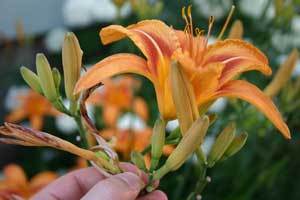 One of the best ways to prolong color in your perennial beds and borders is to deadhead spent flowers. Not only does this encourage reflowering by limiting seed production and self-seeding, it keeps the garden looking neat and tidy by focusing all of the attention on the living flowers. Here are some tips on how to deadhead specific types of perennials.
One of the best ways to prolong color in your perennial beds and borders is to deadhead spent flowers. Not only does this encourage reflowering by limiting seed production and self-seeding, it keeps the garden looking neat and tidy by focusing all of the attention on the living flowers. Here are some tips on how to deadhead specific types of perennials.
Don't worry about buying special tools. You can use your fingers for the job, or a pair of sharp scissors or shears for tougher stems.
Here are the questions asked by community members. Read on to see the answers provided by the ThriftyFun community.
Is it necessary to dead head dianthus?
Hardiness Zone: 8a
Holly from Richardson, TX
Hi Holly,
The short answer is ... Yes, they should be deadheaded.
Here's some additional maintenance info for you. I hope it's helpful.
Dianthus Maintenance: Do not mulch all the way around the Dianthus or you will encourage stem rot. Clumps can be divided every 2 or 3 years to encourage better flower production. Snipping blooms off for cut flower arrangements, or deadheading faded blooms will encourage better flower production.
Good Luck!
Joyce
Zone 5 MA
I live i N. Texas. I was told a year or two ago that Dianthus is mostly like an annual in our area, which explains why I couldn't get it to survive or return the next year. I love them, but if they don't return, they can't stay....lol.
I've discovered that native plants and grasses are the better choices, along with . If I have the seed I plant bloomers in large pots and take them inside in winter to try to get them to survive. Geranium is a good one, ground covers have blooms, Iris comes in wonderful TRIcolor blooms and need so little care, although short bloomers;
My yard is truly organic, and plants seem to love it so much that it's overgrown with foliage, wild in a few areas. However, what grows is either a native, bloomer or is edible for the most part, with fragrant trees such as Chinese Privet, Bradford Pear, Crepe Myrtle, Cherry Laurel, even dwarf mature boxwood. All do well in Texas if not overwatered.
I encourage low maintenance plants, like Autuum Joy
Sedum, Varigated Lirope, lillies, Varigated Vinca Major, Dwarf Monkey Grass, Autumn and Texas Sages, Mexican Petunia, Lemon Balm, Rubra Basil, Eleagnus, Clearya shrubs and many more indiginous to Texas. Tarragon is a bit rampant, as is the Lemon Balm, but Comfry stays wiithin it's boundaries.
I have wild wood violets(like lettuce), and common clover(try it if you like lemon flavor), that are edible, along with wild raspberries and Elephant Garlic that return faithfully with the the Apple, and Plum trees. I grow dandelion greens, Cilantro, and Parsley for my house Bunnies. Tomatoes grow and bloom for some folks, but not me. I have learned to love the blooms on all native plants and not spend so much time on things like Dianthus that just rots quickly in the rainy season, and for most folks who keep flowerbeds enriched. Pots might work much better. Good luck and God bless and help you. : )
Hope something here helps? Good luck and God bless. : )
imho, no flowering plant HAS to be deadheaded. You deadhead when you want it to make more flowers. Some plants will rebloom and others only bloom once per growing season.
I know that the groundcover known as pinks is related to dianthus. Some dianthus go by the common name of carnation. If you run the lawnmower over pinks, they rebloom. Hope this is of some help in answering your question.
good luck
Should chive flowers be clipped to keep chives coming?
By Lynn G
Yes, if the floweres are left on the engery of the plant goes into making seeds.
This is a page about deadheading a hydrangea. Deadheading, unlike pruning, involves just removing the faded, withered blooms on your hydrangea plant.
Dead head your roses just above a five leaf cluster, cutting at an angle. This practice will encourage more and sometimes larger blooms. This is a page about dead heading roses.